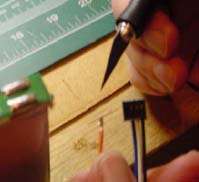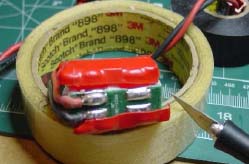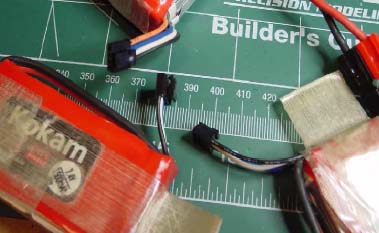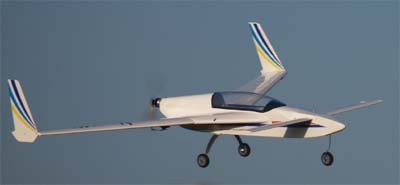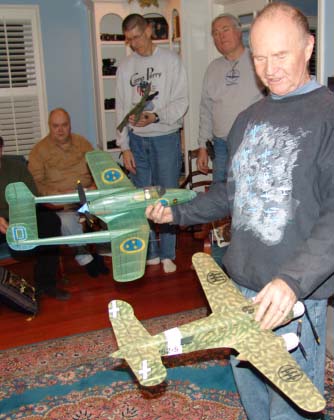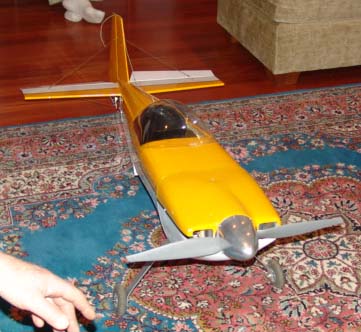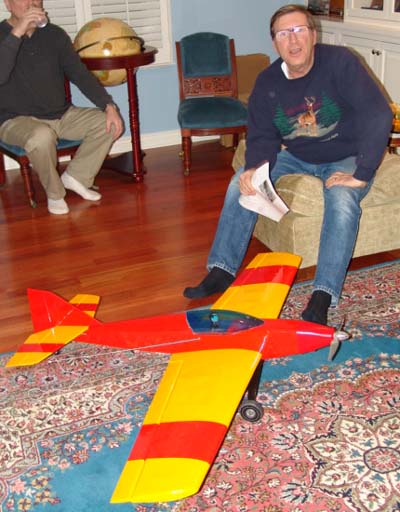 |
Flying High With Electric Power!
The Ampeer ON-LINE!
Fly the Future - Fly Electric! |
Site Table of Contents
| President: | Vice-President: | Secretary/Treasurer: |
| Ken Myers | Richard Utkan | Rick Sawicki |
| 5256 Wildcat | 240 Cabinet | 5089 Ledgewood Ct. W. |
| Croswell, MI 48422 | Milford, MI 48381 | Commerce Twp., MI 48382 |
| (810) 679-3238 | (248) 685-1705 | 248.685.7056 |
 | ||
| Board of Directors: | Board of Directors: | Ampeer Editor |
| David Stacer | Jack Lemon | Ken Myers |
| 16575 Brookland Blvd. | 8908 Sandy Ridge Dr. | 5256 Wildcat Rd. |
| Northville, MI 48167 | White Lake, MI 48386 | Croswell, MI 48422 |
| 248.924.2324 | 248.698.4683 | 810.679.3238 |
| Mailed Ampeer subscriptions are $10 a year US & Canada and $17 a year world wide. FREE on-line! | ||
| The Next Meeting: Date: Thursday, March 2 Time: 7:30 p.m. Place Rick Sawicki's house | ||
|
Presents our First Annual All Electric Fly Saturday, May 20, 2006
Pilots' Meeting: 10 a.m.
Possible Events:
Contact
or Jerry Hanfeld, asst. CD
Adding a Balance Connector to a Li-Poly Battery Pack
This information is being provided for those who feel that they have the necessary skills to do it properly and are willing to take the risk of damaging an expensive Li-Po pack. As in handling all battery packs, care should be taken to see that no cells are shorted, which could cause a fire or personal damage. The plastic bag that the cell is enclosed in is quite thin and easily punctured, extreme caution must be used with "sharp" and "hot" objects in close proximity to these cells! KM First, a few words of caution. In all of the following steps, it is advisable to work with a Li-Poly battery that is in a state of discharge, cells discharged to 3.0 volts, to minimize mishaps. The greatest threat to personal safety is in regard to creating a short circuit while performing any of the following steps. If you are not adept at soldering, you should not proceed.
Step 1 - Preparing the balance connector
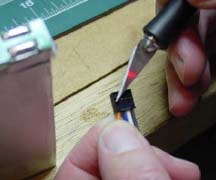
Step 2 - Preparing the pack
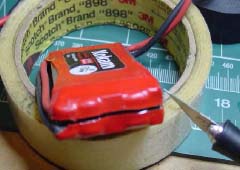
Step 3 - Soldering the balance connector to the pack's circuit board
 First prepare the black lead by cutting it to length (approximately three inches). Then strip off approximately 1/8 inch of insulation from its end.
 The next lead to prepare and solder is the white lead. It is attached on the circuit board where the most negative cell is connected to the next cell (see figure 1).

Here are some views of the finished packs. In the top photo, I included a Thunder Power pack for reference. I used fiberglass reinforced packing tape to re-wrap the packs in their original protective coverings. In the photo on the bottom, you can see fiberglass tape pull-tabs on the two cell packs. These tabs can make removing the packs from a model airplane much easier. Best of all, you don't have to pull on the wires to remove the pack, just pull on the tape. 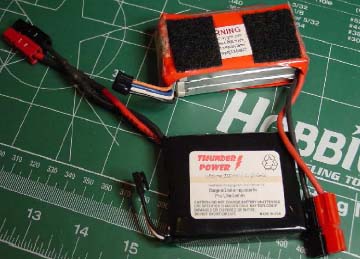
WHY DISCHARGING Li-Poly PACKS In the February '06 Ampeer I described some costly and disappointing experiences I've had with some Li-Po packs. Specifically how my over $500 "investment" in 3-cell 3.2 AH 20C and 2.0 AH 15C packs has been going down the drain. Not only were all six packs notably below their capacity description from the start, but also these packs appeared to be "dieing on the shelf". Basically, they went from "not good" to "worse" in several months of relatively little use. At the same time or longer, other Li-Po brands did no such thing.
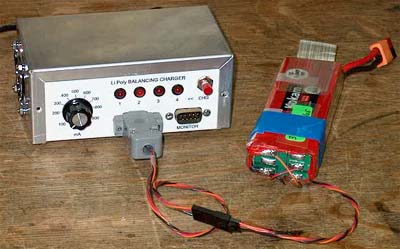 I had previously built and experimented with a balancer circuit and now applied it to this pack. One set of 3 curves (below) shows the response of this pack - "before" (06), "balanced" (07), and after several more cycles (19). It is clear the balancing operation made a big difference in the displayed 1-hour capacity and that several cycles more made little additional improvement. |


|
HOWEVER, there is more to this as shown in the second set of curves. While doing RUN 19 with my CBA I also connected a DATAQ data acquisition device to each of the three cells. The resulting chart (above) therefore displays the individual cell behavior during the same CBA discharge. Notice that curve 3 (cell 3) clearly drops to 3 volts ahead of curves (cells) 1 and 2, and that at CBA cutoff of 9 volts total, cell 3 is already a bit below 2.5 volts. Now imagine where this cell may have gone had I discharged the pack using the "2.5 V/cell" (or 7.5 volts for the pack) standard industry recommendation. Note that "2.5 volts per cell" is the oft-published minimum allowed voltage for Li-Po cells below which "bad things happen". I don't know from experience if this is true, but considering my investment loss to date I'm not anxious to test this. I just accept the 2.5 number as "gospel".
Now I note with some pause the February 2006 issue of Model Aviation, page 10, item (5) under "Emergency Safety Alert: Lithium Battery Fires", this:
This advisory sounds good to me, BUT now what to do with all those costly "normal" Li-Po packs and chargers we all bought? AND - of course - any new balancing product (chargers and batteries) will no doubt be specialized by vendor and the connectors between brands will not match, right?
More On Early Li-Po "Death"
I was very interested to read the recent article in the Ampeer questioning the longevity of Li-Polys. I was beginning to think it was me!!!
Robert RaidenTech Long EZ
Dear Ken: I really appreciate your newsletter! Here's my most recent project... she's a ball to fly! Electric Long EZ from RaidenTech (It comes with a cheap 400 motor which quickly found its way into the box labeled, "I'm keeping this but know I'll never use it.") Wingspan: 55"
It takes off from mowed grass, climbs strongly, cruises well at 2/3 throttle, will loop with a little dive help, will fly inverted, and has very gentle stall characteristics. With the power off it will glide very slowly and land gently. It could be powered with an AXI 2814/12 for a lot more zip if you want it, but you'd have to use the newer 20C series of Li-Po to handle the higher amp draw. All the bestÉ Tom Kempf Small Magnet Source, B-17 Power Update & More
Ken: Very interesting February Ampeer! You guys up north somehow find a way to work around the weather!
Bob Thanks Bob. Actually, the Ampeer has been published since February 1988. It was a paper only publication until 1996. The paper version reached almost 200 subscribers back then. Lots of folding, stapling and stamping! Glad those days are gone. Only about 40 paper subscribers today, but the Ampeer notification email is sent to almost 800 folks, and thanks to you all! :-) Ken The February EFO Meeting Once again, the EFO met at Rick Sawicki's house, and again we thank him for his super hospitality!
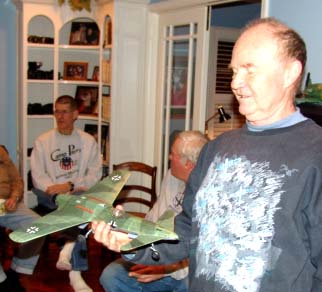
Richard Utkan had the new Cox P-40, which he said flies very well and even faster than he expected! He also had a very nice Steven's Aero DiddleBug, which he also enjoys flying. He said the kit went together well. It is covered with tissue. 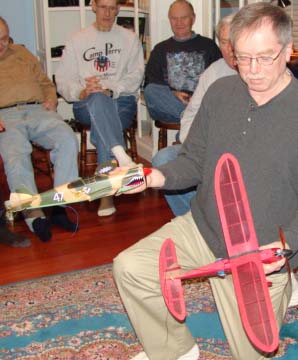 PMAC member, Hank Wildman attended the meeting. He had just come from the PMAC field and shared his Kyosho Corsair, GWS A-10, a C-47 with onboard video and a huge One Design. Hank has done a lot of work on all of the planes, upgrading the power systems, installing retractable landing gear and the like. Hank can be seen pointing out some of the features of the C-47 and Corsair. He noted that the C-47 is not one of the most pleasant planes to fly, while the One Design is EXCELLENT! 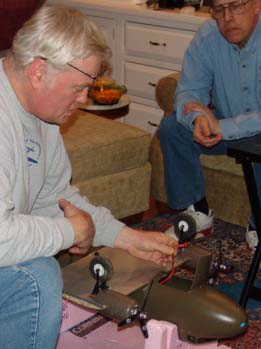
Ken Myers shared his completed Electro Flying Fusion. There will be a review of this great kit in an upcoming Ampeer. Ken noted that this is a craftsman type kit. While it does have some very nicely cut and perfectly fitting laser-cut parts, there still is a lot of carving, sanding and shaping to do. He said that it was a real joy to build! He highly recommends it to anyone looking for a "40" size plane. 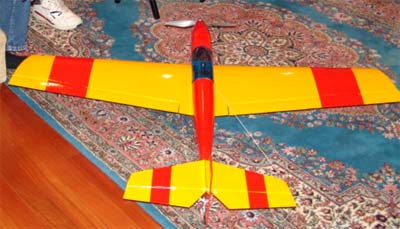
After the extensive show and tell, we all adjourned to Rick's basement for some AirHog bipe flying! Ken, Rick and Richard each had their AirHogs. It was interesting trying to get all three in the air at the same time in the confined area. What a blast! Richard - check for a warp in your wings! Many folks took a turn at trying to see how many laps they could get around the support post! Just way to much fun. There is a short video of some of the action on the Web at: BasementKen.wmv
A Quick Note About the Aero Ace
Nice review in the December issue. I'll try the VCR tape and see if it helps the porpoising.
Thanks,
|
To Reach Ken Myers, you can land mail to the address at the top of the page. My E-mail
address is:
KMyersEFO@theampeer.org
EFO WEBsite
